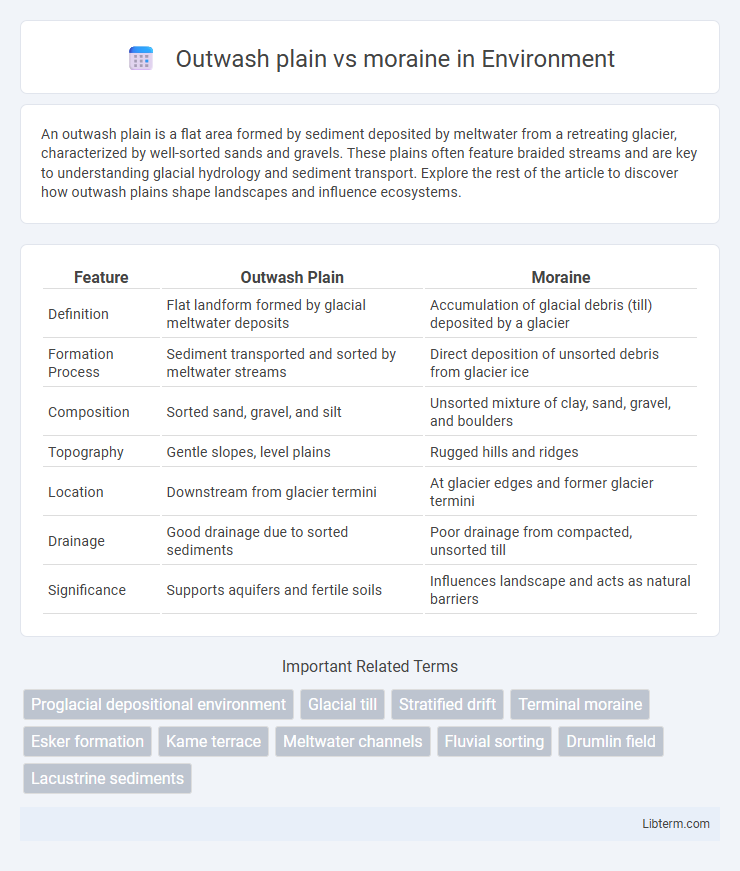An outwash plain is a flat area formed by sediment deposited by meltwater from a retreating glacier, characterized by well-sorted sands and gravels. These plains often feature braided streams and are key to understanding glacial hydrology and sediment transport. Explore the rest of the article to discover how outwash plains shape landscapes and influence ecosystems.
Table of Comparison
| Feature | Outwash Plain | Moraine |
|---|---|---|
| Definition | Flat landform formed by glacial meltwater deposits | Accumulation of glacial debris (till) deposited by a glacier |
| Formation Process | Sediment transported and sorted by meltwater streams | Direct deposition of unsorted debris from glacier ice |
| Composition | Sorted sand, gravel, and silt | Unsorted mixture of clay, sand, gravel, and boulders |
| Topography | Gentle slopes, level plains | Rugged hills and ridges |
| Location | Downstream from glacier termini | At glacier edges and former glacier termini |
| Drainage | Good drainage due to sorted sediments | Poor drainage from compacted, unsorted till |
| Significance | Supports aquifers and fertile soils | Influences landscape and acts as natural barriers |
Introduction to Glacial Landforms
Outwash plains form from sediment deposited by meltwater flowing away from glaciers, creating flat, well-sorted gravel and sand deposits. Moraines consist of unsorted debris directly deposited by a glacier, typically forming ridges or mounds at glacier margins. These contrasting glacial landforms reveal processes of glacial erosion and deposition critical to understanding Pleistocene landscape evolution.
What is an Outwash Plain?
An outwash plain, also known as a sandur, is a broad, flat area formed by glacial meltwater carrying and depositing sediments beyond a glacier's terminus. These plains consist predominantly of stratified sand, gravel, and smaller sediments sorted by flowing water, contrasting with moraines, which are accumulations of unsorted glacial debris directly deposited by ice. Outwash plains play a crucial role in shaping post-glacial landscapes and influencing groundwater recharge due to their permeable sediment layers.
Characteristics of Outwash Plains
Outwash plains are formed by glacial meltwater that deposits stratified sand and gravel, resulting in well-sorted, layered sediments unlike the unsorted till found in moraines. These plains are typically broad, gently sloping areas composed of sediment carried beyond the glacier terminus, often featuring braided river channels and kame terraces. Outwash plains provide distinct hydrological and geological characteristics due to their permeable sediment, which facilitates groundwater recharge and supports diverse ecosystems compared to the more irregular and rocky terrain of moraines.
What is a Moraine?
A moraine is an accumulation of glacial debris such as rocks and soil that has been transported and deposited by a glacier, typically forming ridges along the glacier's edges or at its terminus. Moraines vary in type, including lateral, medial, terminal, and ground moraines, each indicating different parts of glacial movement and melting patterns. Unlike outwash plains, which consist of well-sorted sediments deposited by meltwater, moraines are characterized by unsorted, heterogeneous material directly laid down by glacial ice.
Types of Moraines
Outwash plains are extensive flat areas formed by sediment deposited by meltwater from glaciers, characterized by well-sorted sands and gravels. Moraines, in contrast, are accumulations of unsorted glacial debris deposited directly by ice, including types such as terminal moraines marking the furthest glacier advance, lateral moraines along glacier sides, and ground moraines consisting of a thin layer of till beneath the glacier. Understanding these moraine types aids in reconstructing past glacial movements and landscapes shaped during glacial periods.
Formation Processes: Outwash Plains vs Moraine
Outwash plains form from sediment deposited by meltwater streams flowing away from glaciers, resulting in well-sorted sand and gravel spread over broad, flat areas. Moraines develop from the direct accumulation of unsorted glacial debris, including clay, silt, sand, and boulders, pushed and left behind by the glacier's advancing or retreating ice margin. The formation of outwash plains involves fluvial sorting and sedimentation, while moraines result primarily from glacial ice movement and moraine buildup.
Key Differences Between Outwash Plains and Moraines
Outwash plains are formed by meltwater streams that deposit sorted sediments like sand and gravel, creating flat, layered landscapes. Moraines consist of unsorted glacial debris such as clay, silt, and boulders, accumulated directly by glacier movement and typically forming ridges or mounds. The key difference lies in sediment sorting and depositional processes: outwash plains result from water deposition, while moraines are direct ice deposits.
Ecological and Geological Significance
Outwash plains, formed by meltwater sediment deposition beyond glaciers, create well-drained, nutrient-rich soils supporting diverse plant communities and distinctive wetland habitats. Moraines, consisting of unsorted glacial till deposited directly by ice, shape rolling hills and ridges that influence local hydrology and serve as crucial refuges for boreal forest ecosystems. Both landforms provide valuable records of past glacial activity, contributing to understanding climate change and landscape evolution.
Famous Outwash Plains and Moraines Worldwide
The Outwash Plain of Iceland's Skeidararsandur is renowned for its vast, sediment-rich landscape formed by glacial meltwater, while the Long Island Moraine in New York showcases towering ridges of glacial debris marking ancient ice sheet boundaries. The Platte River Outwash Plain in Nebraska, characterized by well-sorted sand and gravel deposits, contrasts with the distinctive drumlin fields of the Irish Midlands Moraine, which reveal streamlined hills shaped by glacial movement. These famous formations highlight the geological processes of sediment deposition by meltwater in outwash plains versus the direct glacial deposition creating moraines worldwide.
Conclusion: Comparing Outwash Plains and Moraines
Outwash plains and moraines both form through glacial processes but differ significantly in composition and structure; outwash plains consist of stratified sand and gravel deposited by meltwater streams, while moraines are accumulations of unsorted glacial debris directly deposited by ice. Moraines typically form ridges and mounds marking glacier boundaries, whereas outwash plains spread extensive flat areas beyond glacier termini. Understanding these distinctions is crucial for interpreting past glacial environments and sedimentary dynamics.
Outwash plain Infographic

 libterm.com
libterm.com